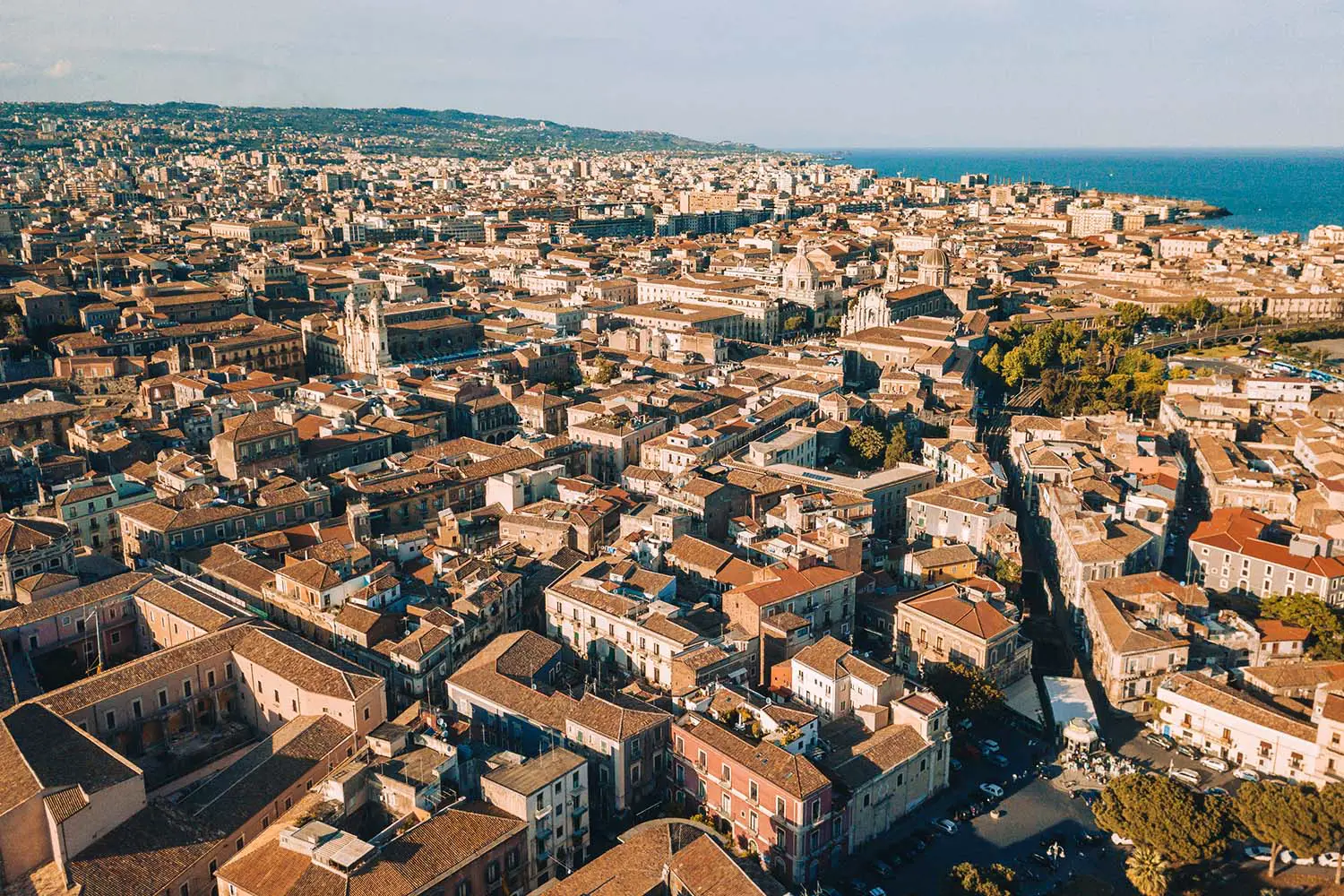Nestled on the sun-kissed shores of eastern Sicily lies Catania, the island’s second-largest city and a beacon of culture, history, and architectural grandeur. As the primary point of entry for many foreign adventurers arriving through the airport just a stone’s throw away, Catania warmly welcomes its visitors with a unique blend of ancient and modern wonders.
The city pulsates with an intense vibrancy, a testament to its resilience and rejuvenation. In the late seventeenth century, a devastating earthquake rumbled across the region, leaving behind a trail of ruin. Yet, from the ashes rose a city adorned with grand architecture, reflecting both its storied past and an optimistic gaze towards the future.
As you wander through its historic centre, encounter its UNESCO World Heritage sites, or simply breathe in the Mediterranean air at the Piazza del Duomo, you’re not just visiting Catania; you’re experiencing a phoenix reborn.
Read on for all the information you need about things to do in Catania.
Historical Significance of Catania
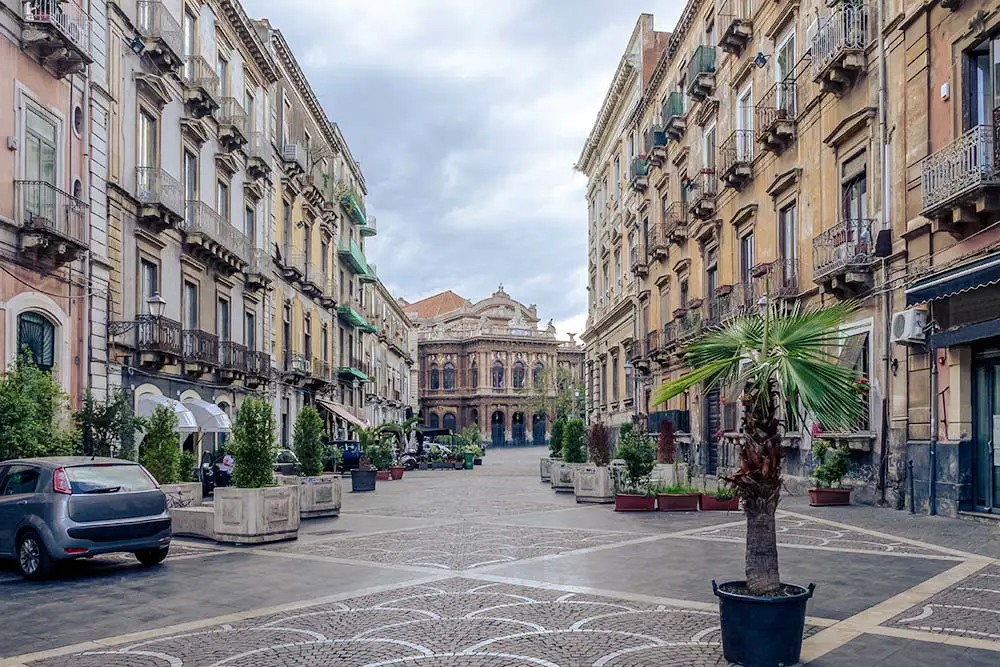
Street of Catania with the famous Opera Theatre Teatro Bellini in the background.
Catania’s roots stretch deep into the annals of history, with tales as old as time echoing through its cobblestone streets. While the resilient spirit of the city is evident in its recovery from natural calamities, its true essence lies in its rich tapestry of cultural and historical milestones that have shaped its identity.
The crowning jewel in Catania’s historical diadem is its status as a UNESCO World Heritage site, a prestigious recognition that speaks volumes about its architectural and cultural treasures. The city, with its strategically located port along the Mediterranean Sea, was historically a crossroads of civilizations. From ancient Greeks to Romans, and from Byzantines to Normans, each left an indelible mark, enriching Catania with a fusion of styles, beliefs, and innovations.
Wandering through the city’s historic center, one can’t help but be captivated by the exquisite baroque architecture, a testament to the city’s renaissance after the seventeenth-century earthquake. The grandiose structures and ornate designs are not mere artistic expressions; they are symbols of Catania’s unwavering determination to rise from adversity, rebuild, and redefine itself.
The ruins of the ancient Greek theater or the Roman amphitheater whisper tales of bygone eras when Catania was a cultural epicenter, a hub of art, philosophy, and innovation.
Moreover, the city’s juxtaposition of ancient ruins with majestic Baroque buildings exemplifies the seamless blend of old and new, where history is not just preserved but celebrated. As one delves deeper into central Catania, landmarks such as the Catania Cathedral or the Palazzo degli Elefanti stand as silent witnesses to the city’s ever-evolving narrative.
In essence, Catania is not just a city; it’s a living museum. Every alleyway, every piazza, and every stone tells a story, painting a vivid picture of epochs gone by, of civilizations that once graced its lands, and of the undying spirit of a city that has faced its share of trials, yet stands tall, proud, and profoundly significant in the annals of history.
Main Attractions in Central Catania
Piazza del Duomo: The Epicenter of Elegance
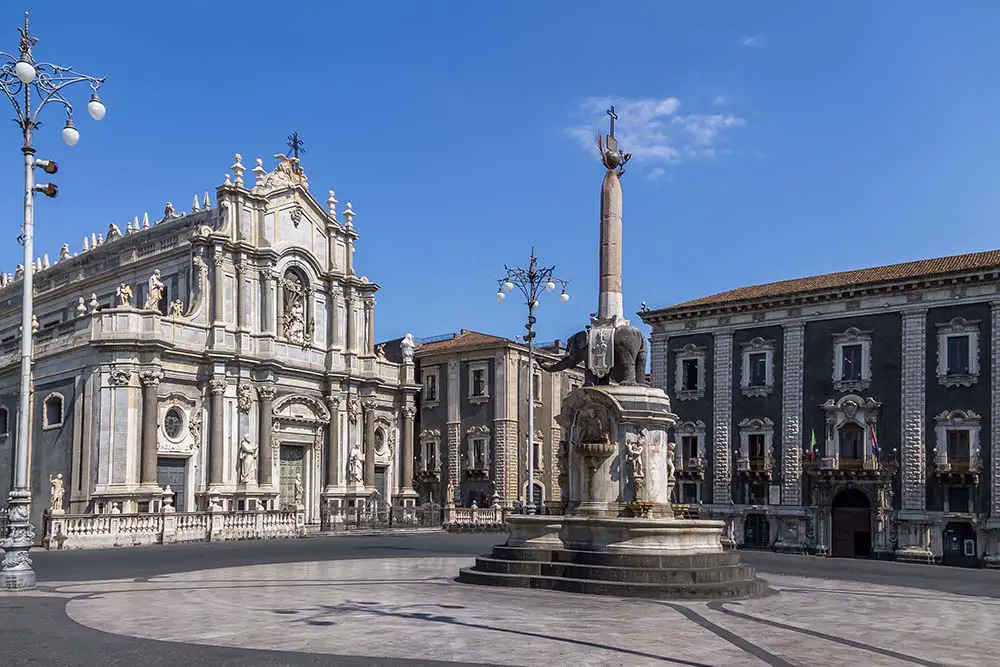
Piazza del Duomo (Cathedral Square) with the Cathedral of Santa Agatha and the Elephant Sculpture Fountain.
At the very heart of Catania lies the Piazza del Duomo, an architectural marvel and a bustling epicenter of the city’s cultural and social life. This square, with its elegant designs and historical significance, perfectly encapsulates the essence of Catania.
Dominating the piazza is the awe-inspiring Catania Cathedral. Originally constructed in the 11th century and dedicated to Saint Agatha, the city’s revered patron saint, the cathedral has borne witness to Catania’s tumultuous history.
Over the years, natural calamities and invasions have necessitated multiple reconstructions, and today’s edifice, graced with baroque architecture, stands as a testament to the city’s undying spirit and resilience. With every stone, column, and altar, the cathedral narrates tales of faith, endurance, and rebirth.
Adjacent to the cathedral, one cannot miss the iconic Elephant’s Fountain. This emblematic monument, made of lava stone, carries an obelisk on its back and is affectionately known to the locals as ‘Liotru’. Steeped in legends and mysteries, this emblem symbolizes the historic strength and ancient origins of Catania.
Flanking the piazza, the Palazzo degli Elefanti, or the Elephant Palace, stands with an air of regality. Serving as the city’s town hall, its majestic facade and intricate details are fine examples of the Sicilian Baroque style that flourished after the seventeenth-century earthquake. The palazzo is not just an administrative hub but a celebration of Catania’s architectural prowess.
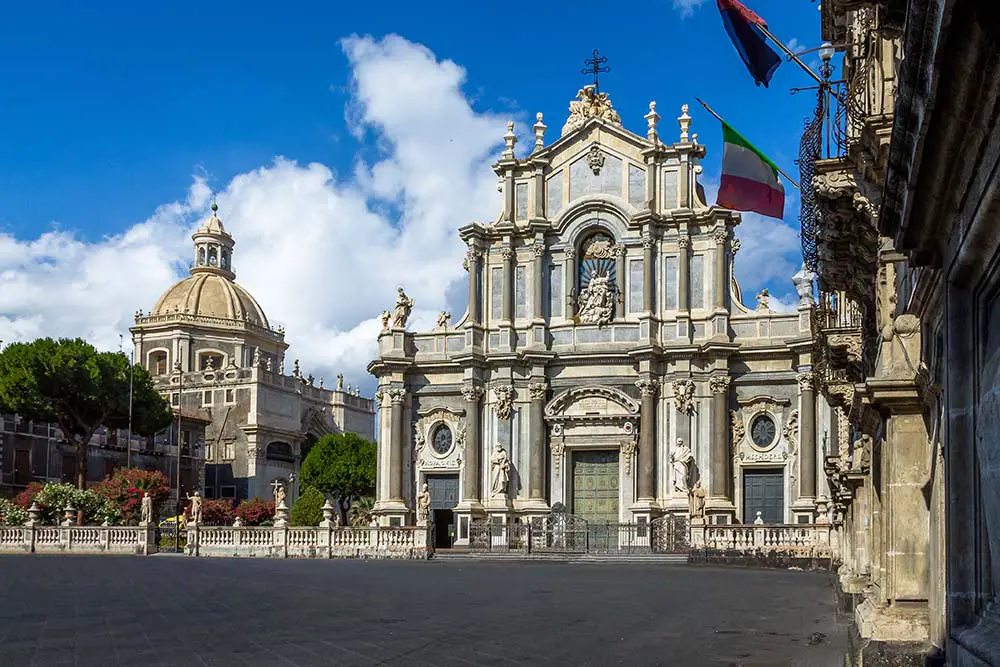
Cathedral of Santa Agatha at Piazza del Duomo in Catania.
Another gem in the vicinity of the Piazza del Duomo is the Fontana dell’Amenano. This elegant fountain marks the spot where the Amenano River once flowed openly before being driven underground. Today, it’s a symbol of the seamless blend of nature and artistry in Catania.
Indeed, the Piazza del Duomo is not just another square; it’s the pulsating heart of Catania. No matter if you’re admiring the intricate details of the Catania Cathedral, indulging in some people-watching at a nearby café, or simply soaking in the Mediterranean sea air, this square is where the soul of Catania Sicily truly comes alive.
Piazza Federico di Svevia: A Historical Nexus
Nestled a stone’s throw away from central Catania lies the atmospheric Piazza Federico di Svevia. This square, less bustling but equally significant, carries whispers of Catania’s medieval past.
At the heart of this piazza stands Castello Ursino, an imposing fortress built under the reign of Frederick II, the Holy Roman Emperor. With its robust castle walls and storied past, it offers a journey back to the 13th century when Catania was a strategic stronghold in eastern Sicily. Once surrounded by the Ionian Sea, the castle’s location now, miles away from the coast, is a testament to the volcanic activities of Mount Etna that reshaped the landscape.
Surrounded by quaint cafes and boutiques, Piazza Federico di Svevia is more than just a historical site; it’s a rendezvous point between Catania’s medieval past and its vibrant present.
Piazza Carlo Alberto: The Marketplace of Traditions
Piazza Carlo Alberto, with its bustling ambiance and rich heritage, serves as a vibrant snapshot of Catania’s daily life. Located in central Catania, this square is a fusion of historic architecture and the lively spirit of the Sicilian people.
Dominating the square is the Catania Fish Market. Here, the age-old traditions of Catania come to life as vendors showcase an array of fresh catches from the Mediterranean Sea. The melodic chants of sellers, the intoxicating aroma of the sea, and the rich palette of colors from various seafood create an experience that’s quintessentially Catania.
Overlooking the market is the San Francesco Church, a sublime structure with baroque architecture that harks back to the city’s historic reverence for art and faith. Its grand facade and solemn interiors offer a serene contrast to the lively market below.
On Saturdays, Piazza Carlo Alberto transforms into a bustling flea market, where antiquities, crafts, and local delicacies find eager buyers. From dawn till dusk, the square remains a hub of activity, capturing the essence of Catania’s traditions, resilience, and the undying spirit of its people.
Via dei Crociferi: A Journey Through Baroque Splendor
Meandering through the heart of Catania, Via dei Crociferi is more than just a street – it’s a magnificent tapestry of Baroque architecture and a testament to Catania’s post-earthquake resurgence. As you stroll along this historic avenue in central Catania, the intricate facades and grand archways transport you to a bygone era.
Prominent among its treasures is the Church of San Benedetto, with its ornate facade and the famous arch, Archi della Marina, stretching over the street in a grand embrace. The church’s interiors, a symphony of artistry and faith, mirror the city’s dedication to preserving its spiritual and architectural heritage.
Adjacent lies the Monastery of San Nicolò, an epitome of the Baroque splendor that the Val di Noto region is celebrated for. Also lining this street are gems like Santa Filomena and the Roman Theatre (Teatro Romano), each structure narrating tales of Catania’s resilience and renaissance.
A walk down Via dei Crociferi is not just a tour of buildings but a journey through time, capturing the essence of Catania’s transformative spirit and its undying love for art, faith, and history.
Roman Theatre (Teatro Romano): Echoes of Ancient Performances
Hidden beneath the bustling streets of Catania’s city center, the Roman Theatre (Teatro Romano) emerges as a silent sentinel of the city’s ancient past. This archaeological marvel, tucked away amidst the baroque splendors of Via dei Crociferi, stands as a compelling reminder of Catania’s place in the larger tapestry of the Roman Empire.
Constructed primarily from lava stone – a nod to the ever-present influence of Mount Etna – the theatre has witnessed countless performances, echoing the laughter and applause of spectators from millennia past. Its semi-circular orchestras, expansive seating tiers, and the still-visible stage area transport visitors back to a time when gladiators, tragedians, and comedians graced its grounds.
Adjacent to the theatre, the Odeon, a smaller and more intimate performance space, complements the grandeur of the Teatro Romano. The meticulous design and layout of these structures highlight the Romans’ unparalleled architectural genius and their commitment to entertainment and art.
Visiting the Roman Theatre isn’t just about admiring ancient stones; it’s about immersing oneself in the rhythms of ancient Catania, hearing the distant sounds of instruments, and feeling the pulse of a civilization that shaped the Mediterranean and beyond.
Civic Museum: A Portal to Catania’s Storied Past
Perched within the robust walls of Castello Ursino in Piazza Federico di Svevia, the Civic Museum of Catania stands as a beacon of the city’s rich heritage. It serves not just as a repository of art and artifacts but as a narrative, recounting tales from Catania’s eventful past.
From the moment you step within its chambers, you’re invited on a journey that spans millennia. The museum houses an extensive collection that ranges from ancient Greek and Roman artifacts to more contemporary art pieces, each echoing the diverse influences that have shaped Catania.
A standout attraction is the assortment of sculptures, remnants from the Roman era, that once adorned the city’s public spaces. Equally captivating are the intricate paintings that depict scenes of Catania’s life through the ages, from the medieval period, through its baroque renaissance, up to the modern era.
But it’s not just about artifacts; the Civic Museum, located within the UNESCO World Heritage Site of Catania, is a testament to the city’s resilience. The castle itself, having withstood volcanic eruptions, earthquakes, and wars, epitomizes the spirit of Catania – enduring, evolving, and ever vibrant.
Exploring the Civic Museum is an essential experience for those keen to delve deep into the heart of Catania’s history, culture, and undying spirit.
Castello Ursino: Catania’s Fortress of Timeless Resilience
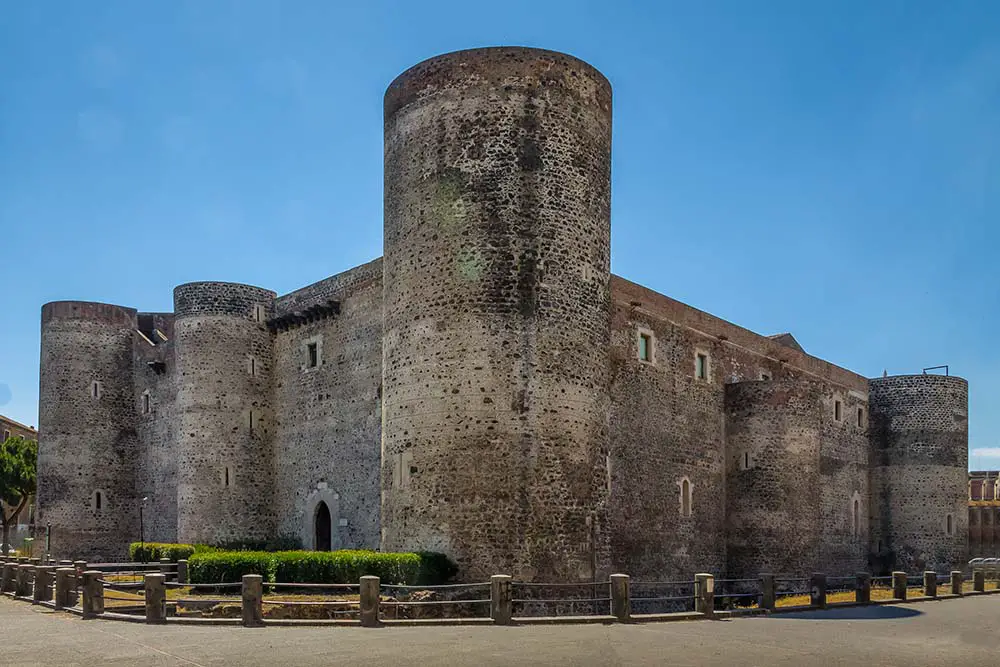
Castello Ursino (Ursino Castle) or Castello Svevo di Catania.
Majestically standing in the heart of Catania, Castello Ursino is more than just a castle; it’s a symbol of the city’s enduring spirit and a chronicle of its tumultuous past. Initially built as a coastal fortress by Frederick II, the Holy Roman Emperor, this imposing structure now finds itself inland, testament to the dramatic geographical changes inflicted by Mount Etna’s eruptions.
Surrounded by its formidable castle walls, a walk through its vast courtyards and dimly lit corridors takes one on a journey back to the medieval ages. Each stone, each archway whispers tales of knights, sieges, and political intrigue. Inside, the castle seamlessly integrates its military origins with its present role as the home of the Civic Museum. The display of artifacts and art within these ancient walls creates a vivid contrast, celebrating both Catania’s martial and cultural legacies.
The castle’s location in Piazza Federico di Svevia offers a panoramic view of central Catania, with its Baroque architecture and bustling squares, showcasing the harmonious blend of old and new that characterizes the city.
Visiting Castello Ursino is an immersion into the very soul of Catania, where resilience meets artistry, and history mingles with the vibrancy of the present.
Fontana dell’Amenano: Where Water Dances with History
Nestled between the grandeur of Piazza del Duomo and the lively Catania Fish Market, the Fontana dell’Amenano stands as a poetic emblem of Catania’s deep connection with water and nature. This graceful fountain, with its silvery cascade, serves as a gentle reminder of the river Amenano, which once flowed openly through Catania but now runs silently beneath its streets.
Crafted from pristine Carrara marble, the fountain depicts the river god Amenano, from whose overturned urn flows a shimmering sheet of water, symbolizing the underground river. On days when the sunlight catches its waters just right, the fountain seems to shimmer and dance, earning it the affectionate moniker “Acqua a linzolu” or “water on a bedsheet” among locals.
Its proximity to the Mediterranean Sea and central Catania makes the Fontana dell’Amenano an ideal spot for both contemplation and people-watching. Here, amidst the hustle and bustle of city life, visitors can pause, listen to the gentle murmur of water, and reflect on Catania’s ever-evolving dance between its ancient past and dynamic present.
Nature and Outdoor Activities
Mount Etna: An Unforgettable Day Trip to Europe’s Tallest Active Volcano
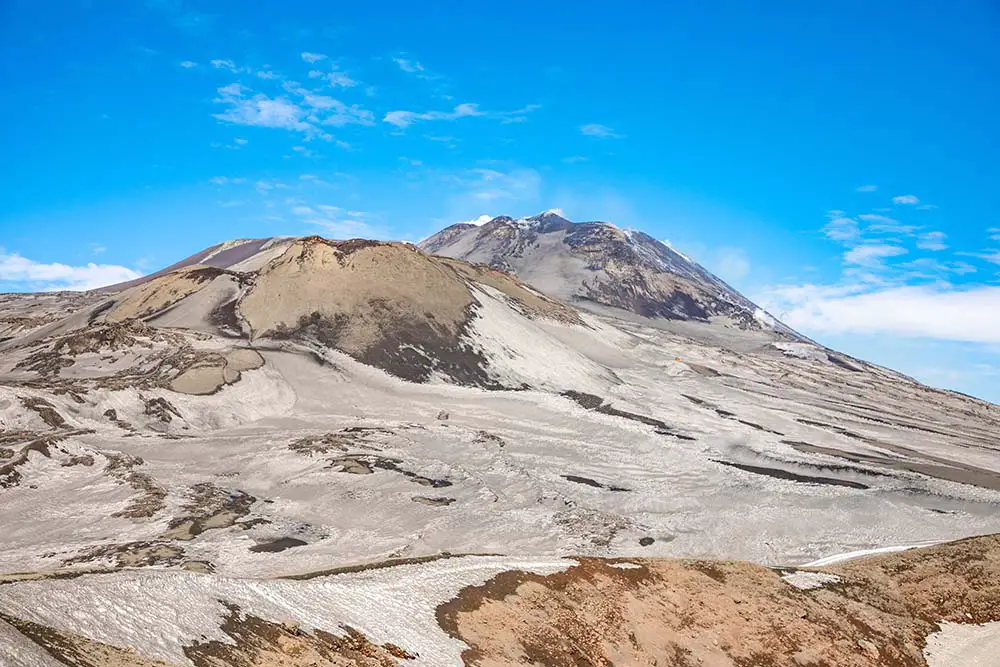
The volcano Etna, as seen from Catania.
If Catania is the heart of eastern Sicily, then Mount Etna surely is its pulsating beat. Towering over the landscape, this formidable natural marvel, recognized as Europe’s tallest active volcano, promises visitors an unparalleled day trip experience.
Imagine standing at the edge of a smoldering crater, feeling the ground’s warmth underfoot and the cool Mediterranean breeze against your face, all while soaking in panoramic views that stretch from the shimmering Ionian Sea to the rugged interiors of Sicily. It’s an experience that few places on Earth can rival.
For those keen to delve deeper, a myriad of “visit Mount Etna” tours offer curated experiences tailored to individual preferences. Whether it’s hiking along ancient lava flows, exploring the volcanic caves, or witnessing the ethereal glow of an eruption from a safe distance, Etna caters to both the adventure enthusiast and the contemplative soul.
But what truly sets a day trip to Mount Etna apart is its accessibility. In just a short journey from the bustling streets of central Catania, one can transition from the urban to the ethereal, making it a must-visit for anyone gracing the east coast of Sicily.
So, while you might have read extensively about Mount Etna’s geological wonders and historical significance, nothing quite prepares you for the raw, unfiltered encounter of standing atop its grandeur, even if just for a day.
Ionian Sea: Beach Bars, Sea Air, and Relaxation
Just a stone’s throw from Catania’s historic center, the shimmering waters of the Ionian Sea beckon visitors to its sun-kissed shores. Here, the rhythmic ebb and flow of waves harmonize with the chatter from bustling beach bars, creating an ambient soundtrack for those seeking relaxation.
Inhale the invigorating sea air, rich with hints of salt and seaweed, as you recline on a sun lounger or stroll along the sandy expanse. As dusk approaches, the horizon transforms into a canvas of fiery oranges and deep purples, providing the perfect backdrop to a refreshing Aperol spritz.
In Catania, the Ionian Sea isn’t just a coastal retreat—it’s a sensory celebration.
Isola Bella Island and Aci Castello: Nature’s Marvel Near Catania
Nestled off the eastern coast of Sicily, Isola Bella Island is a tiny gem that epitomizes nature’s splendor. Often dubbed as the ‘Pearl of the Ionian Sea’, this island captivates with its lush greenery, rocky outcrops, and secluded pebble beaches. Just a short boat ride from Catania, Isola Bella offers a serene escape from the city’s hustle.
But nature’s showcase doesn’t end here. Further up the coast, the imposing silhouette of Aci Castello rises from the sea. This ancient, volcanic castle, perched on a rocky cliff, stands as a testament to Catania’s rich history intertwined with tales of love, betrayal, and battles. Together, Isola Bella and Aci Castello form a duo of unparalleled beauty, waiting to be explored by those venturing beyond central Catania.
Villa Bellini (Giardini Bellini): Catania’s Verdant Oasis
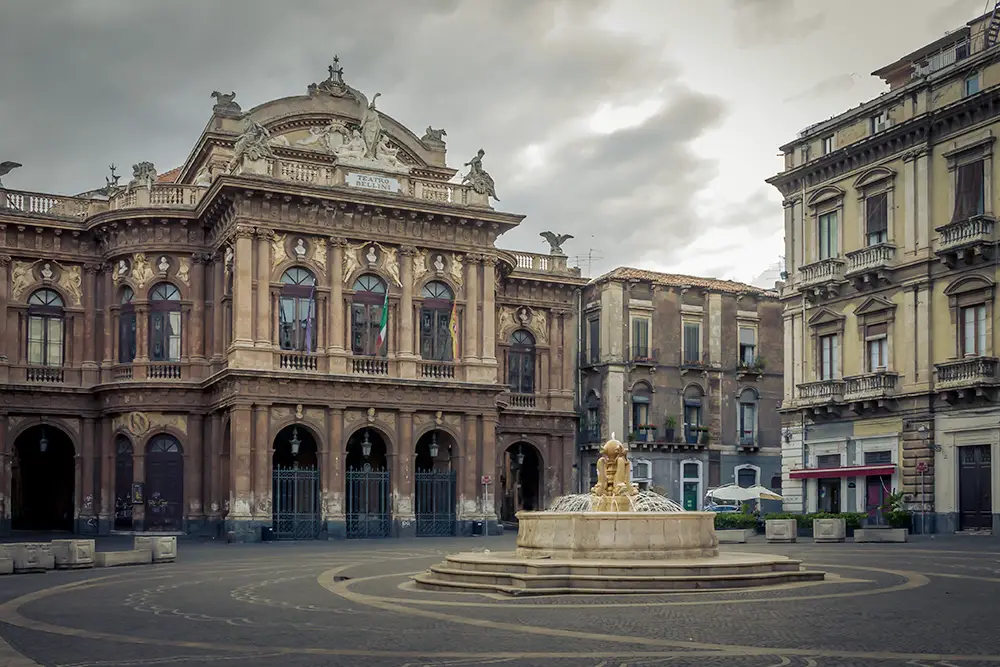
Amidst Catania’s urban sprawl, Villa Bellini, also known as Giardini Bellini, emerges as a sanctuary of tranquility and beauty. As you stroll through its meticulously manicured pathways, the symphony of rustling leaves and melodious bird calls transport you to an idyllic world. Statues of famous personalities, including the renowned composer Vincenzo Bellini after whom the park is named, dot the landscape, narrating tales of Catania’s artistic legacy.
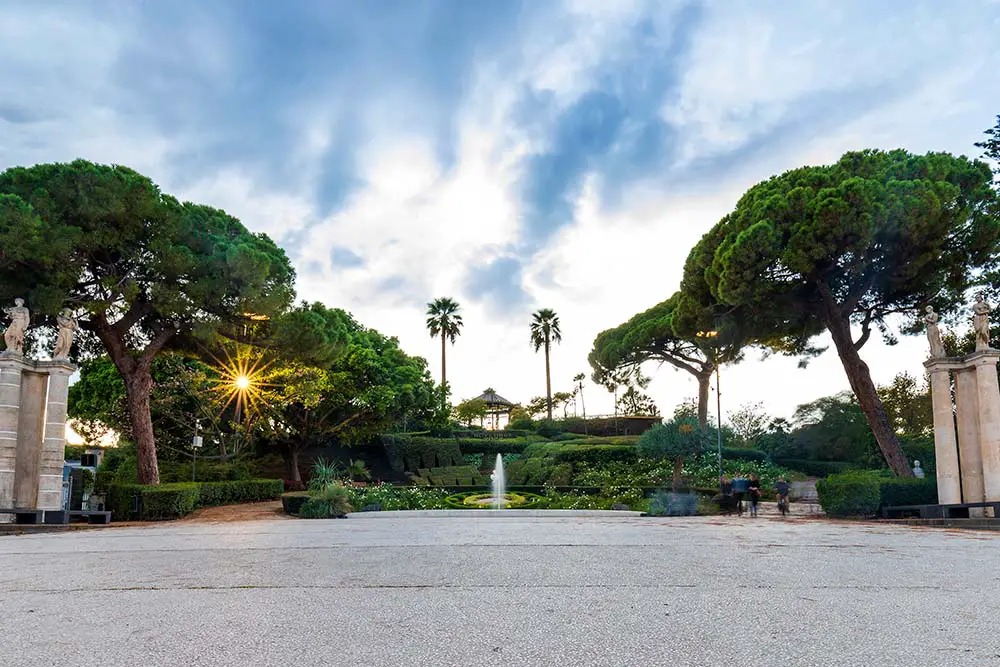
Bellini garden.
With a delightful fusion of Baroque fountains, vibrant floral displays, and ancient trees, this sprawling park in central Catania offers residents and tourists alike a respite from the city’s bustling rhythm. Whether it’s a morning jog, an afternoon of leisurely reading, or a family picnic, Villa Bellini encapsulates the essence of Mediterranean relaxation.
Religious and Spiritual Sites
Catania, with its rich tapestry of history, is home to an array of sacred spaces that echo tales of devotion, artistry, and architecture. From ancient chapels to grand cathedrals, these spiritual sites are a testament to the city’s deep-rooted faith and its confluence of cultures over the centuries.
Saint Agatha: The City’s Patron Saint and Her Significance
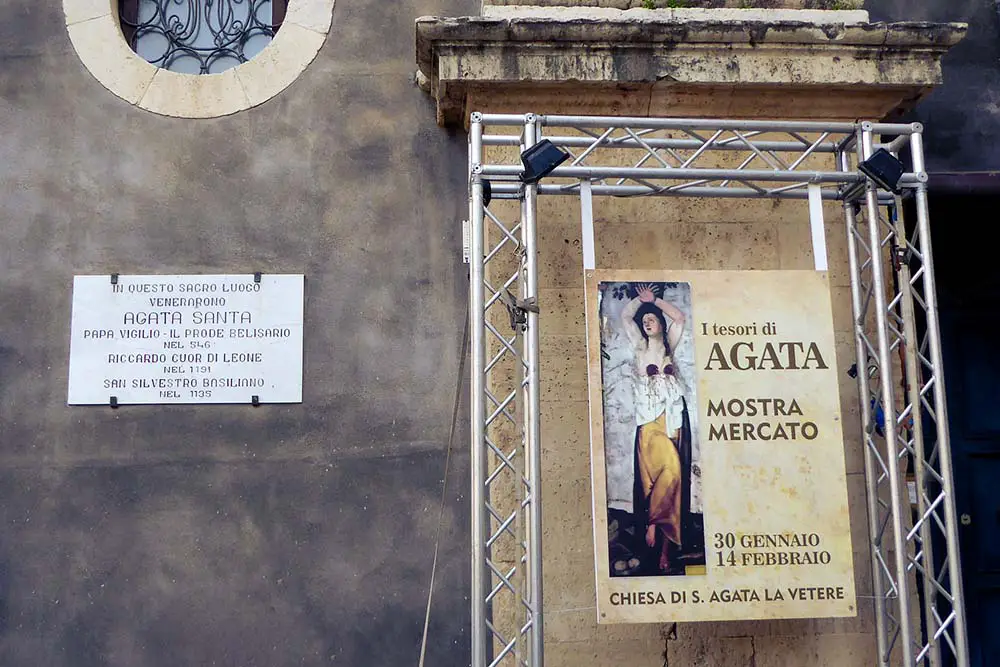
Saint Agatha, Catania’s revered patron saint, holds a position of profound importance in the heart and soul of the city. Born in Catania, her unwavering faith and ultimate martyrdom in the face of persecution have made her a beacon of strength and devotion for the locals.
Every year, her legacy is celebrated with fervor during the Feast of Saint Agatha, a grand procession marked by the carrying of her relics, traditional rituals, and the throngs of faithful that gather in central Catania. Her enduring spirit is not just a religious emblem but also a reflection of the resilience and passion of the Catanian people themselves.
San Francesco Church and San Benedetto Church: Twin Pillars of Devotion
In the heart of Catania’s historic center, the San Francesco Church stands as an epitome of baroque architecture and spiritual reverence. Its intricate facades and opulent interiors, adorned with frescoes and ornate decorations, narrate tales of Catania’s religious fervor and artistic prowess.
The hallowed halls resonate with hymns sung over centuries, encapsulating the essence of eastern Sicily’s spiritual traditions.
A short walk away, the San Benedetto Church dazzles with its exceptional frescoes, especially the acclaimed scenes on its vault depicting moments from the life of St. Benedict. The church, part of the larger complex of the Monastero dei Benedettini di San Nicolò, showcases a harmonious blend of architectural styles, bearing witness to various epochs of Catania’s history.
Together, these two churches stand as timeless sentinels, guarding the city’s rich spiritual and artistic heritage.
Monastero dei Benedettini di San Nicolò (Benedictine Monastery): A Spiritual and Architectural Gem
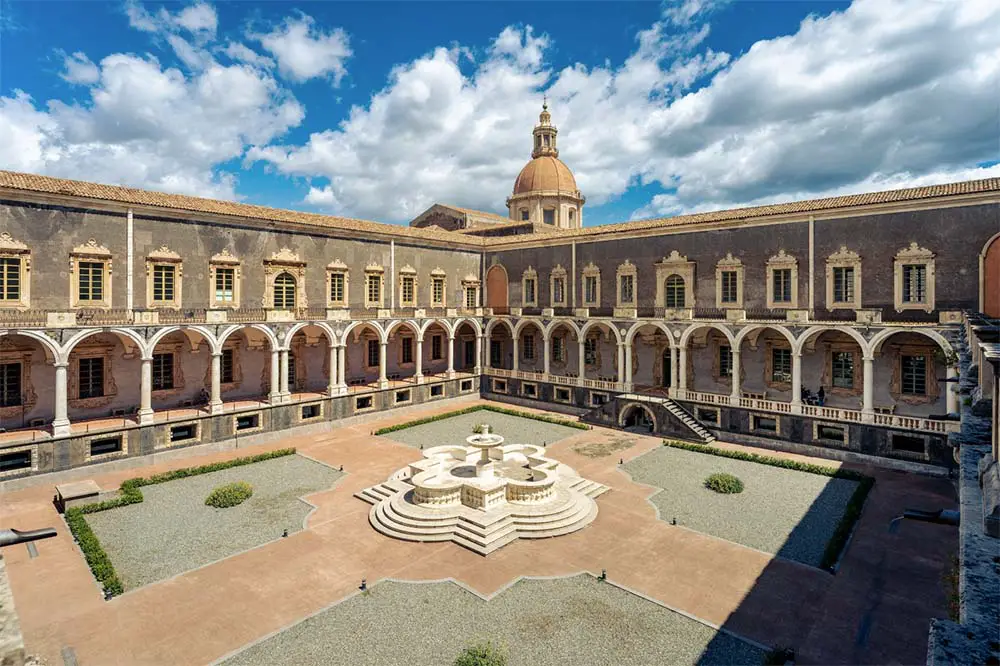
Monastery of San Nicolò l’Arena (Photo: www.monasterodeibenedettini.it)
Nestled in the heart of Catania, the Monastero dei Benedettini di San Nicolò stands as a testament to the city’s monastic heritage and architectural grandeur. As one of the largest Benedictine monasteries in Europe, it’s a sprawling complex that boasts a harmonious blend of Baroque and renaissance styles. Its hallowed walls have echoed with prayers and chants of monks for centuries, making it a focal point of spirituality in eastern Sicily.
But it’s not just a place of worship. The monastery is also home to the University of Catania’s Department of Humanities, showcasing a unique juxtaposition of ancient devotion and contemporary academia. With its captivating cloisters, intricate frescoes, and historical archives, the Monastero dei Benedettini di San Nicolò invites visitors to embark on a journey through Catania’s spiritual and educational legacy.
Santa Filomena: A Lesser-Known Treasure of Faith
Amidst the more prominent landmarks of Catania, the church of Santa Filomena stands as a quaint, yet profoundly significant symbol of devotion. Though it might not share the same grandeur as some of its more celebrated counterparts, its charm lies in its intimate atmosphere and the heartfelt stories it houses. Dedicated to Saint Philomena, a young martyr venerated for her unyielding faith, this sanctuary holds a special place in the hearts of many Catanians.
The church’s architecture reflects the baroque elements iconic to the city, and within, one finds a serene space for reflection and prayer. For those delving deeper into Catania’s religious fabric, Santa Filomena offers a genuine and unembellished experience of the city’s spiritual character.
Culture and Lifestyle
Catania, with its rich tapestry of history and traditions, pulsates with a culture and lifestyle that’s unmistakably Sicilian. Dive into the city’s vibrant streets, and you’ll be embraced by an eclectic blend of ancient customs, modern rhythms, and the passionate spirit of its people.
Sicilian Street Food: Dive into the Local Flavors and Delicacies
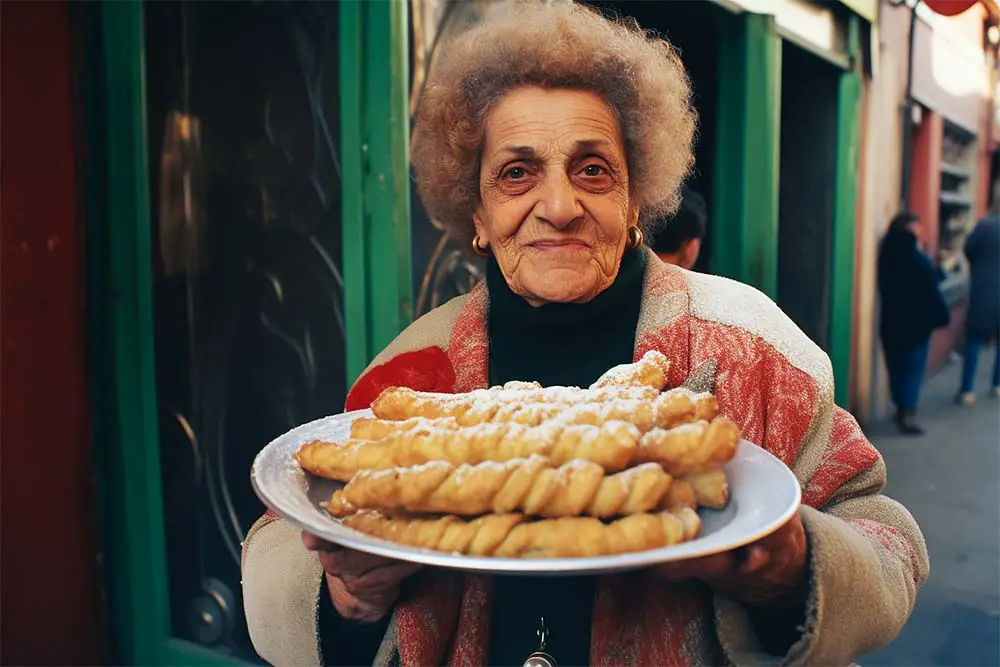
Every visit to Catania is incomplete without indulging in the mouth-watering array of Sicilian street food that tells a tale of the island’s culinary journey. As you wander the lively streets of central Catania, the aromatic whiffs of freshly cooked treats beckon you to take a flavorful plunge into the city’s gastronomic heart.
At the heart of this culinary adventure is the bustling Catania Fish Market, a spectacle of daily life where fresh catches from the Ionian Sea are transformed into delectable dishes. Here, you can savor delicacies like “arancini” – deep-fried rice balls filled with a medley of ingredients, or the iconic “pasta alla norma”, a tribute to Catania’s love affair with eggplants.
But it doesn’t end there. Venture further, and you’ll come across vendors offering “cannoli”, a sweet ricotta-filled pastry, or “granita”, an icy treat perfect to beat the Mediterranean heat. As you navigate the streets, don’t miss out on “pane e panelle”, chickpea fritters sandwiched between slices of bread, a testament to the city’s humble and hearty food traditions.
In Catania, every bite captures the essence of its history, landscape, and the vibrant lifestyle. From humble stalls to more upscale eateries, the city’s food scene offers a palette of flavors, making visiting Catania an unforgettable culinary journey for every food enthusiast.
Pasta alla Norma: Catania’s Iconic Dish and Its History
While Catania’s street food scene tantalizes with its varied offerings, there’s one dish that stands as a proud emblem of the city’s culinary heritage: pasta alla norma. Delving into this dish is much like journeying through the city’s history, where flavors converge, telling tales of Catania’s past and present.
Named in honor of Vincenzo Bellini’s opera “Norma”, this dish, much like the opera, harmoniously brings together contrasting elements. At its base, pasta alla norma features tender pasta, often maccheroni or rigatoni, which is then generously adorned with a rich tomato sauce. The hero of the dish, however, is the golden fried eggplant, which, when layered onto the pasta, pays homage to Catania’s abundant agricultural fields and the Mediterranean’s generous bounty.
Topping this masterpiece is a sprinkle of salty ricotta salata cheese and fresh basil leaves, symbolizing the peaks of Mount Etna and the verdant landscape of eastern Sicily.
No visit to Catania is complete without savoring this dish, preferably in a bustling piazza with the backdrop of Baroque architecture and the soft melodies of street musicians. As you indulge in this Catania classic, you’re not just savoring a meal; you’re experiencing a piece of the city’s soul, a culinary testament to Catania’s enduring love for food, art, and history.
Catania Fish Market: A Culinary Adventure Beneath the Surface
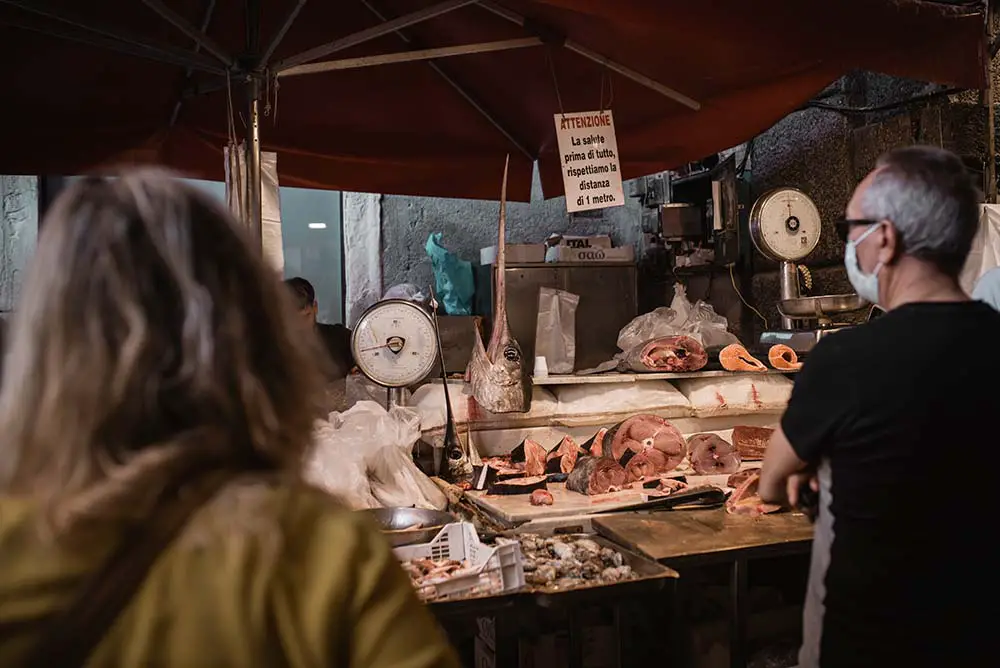
The fish market in Catania bustling with commerce.
The rhythmic chants of vendors, the glint of fresh catches under the morning sun, and the lively banter of locals bartering for the best prices – all this paints a vivid picture of the Catania Fish Market. Nestled in the heart of the city, just a stone’s throw from Piazza del Duomo, this bustling market is a testament to Catania’s deep-rooted bond with the Mediterranean Sea.
More than just a place to buy fish, the market is a sensory explosion. Stroll through the lanes and be captivated by stalls overflowing with shiny anchovies, tender octopus, and regal swordfish, displaying the bounty of the Ionian Sea. The air is rich with the scent of the sea and intertwined with the mouth-watering aroma of Sicilian street food stalls nearby, offering delightful bites that pair beautifully with the fresh seafood on sale.
For those visiting Catania, the fish market isn’t merely a shopping destination; it’s an immersive cultural experience. It’s where age-old traditions meet daily life, and where tales of fishermen’s adventures come alive with every purchase. A wander through this market offers a glimpse into the very essence of Catania’s lifestyle – a dance of tradition, sustenance, and the timeless connection to the sea.
Via dei Crociferi: Strolling Through Time Amidst Baroque Splendor
As you transition from the savory aromas of the Catania Fish Market, the city presents yet another mesmerizing facet – the Via dei Crociferi. A testament to Catania’s resilience and flair, this historic street stands as a grand tapestry woven with tales of centuries gone by. Dotted with architectural masterpieces, the Via dei Crociferi showcases Catania’s profound commitment to Baroque architecture, an art form born out of destruction and rebirth following the devastating earthquake in the late 17th century.
The street itself, framed by ornate churches, ancient monasteries like the Benedictine Monastery, and palatial residences, is a journey through time. Each edifice, with its intricate carvings, seems to whisper tales of nobility, faith, and the undying spirit of the people of Catania Sicily. The shadowy arches, which span overhead, create a delightful interplay of light and dark, reminiscent of Catania’s history of triumph over adversity.
As you tread the cobbled pathways of Via dei Crociferi, be sure to pause, look around, and soak in the ambiance. Every corner holds a narrative, and every stone has a story, making it not just a street, but a living testament to Catania’s rich cultural tapestry.
Getting Around Catania
Navigating Catania offers a blend of the old and the new, encompassing its rich history while catering to modern travelers. Here’s a guide to understanding the best modes of transportation available in the city and ensuring a smooth journey.
Catania Centrale Station: The City’s Main Transport Hub
As the beating heart of Catania’s transport system, Catania Centrale Station provides both locals and tourists with an efficient way to traverse the city and beyond. Located in central Catania, this bustling station connects the city to other key Sicilian destinations, making it the perfect starting point for regional adventures. Whether you’re catching a train to Palermo or embarking on a picturesque journey along the east coast, the Centrale Station is your gateway.
Rental Car vs. Walking: Is Catania a Walkable City?
Catania’s historic centre, with its narrow streets, baroque architecture, and iconic sites like Piazza del Duomo, is best explored on foot. The central squares and attractions are relatively close, allowing travelers to soak in the city’s charm at a leisurely pace. That said, if you’re aiming to explore the outskirts or nearby attractions like Mount Etna, renting a car becomes advantageous. Many “catania tours” also offer guided excursions to these destinations. While the city itself is walkable, a combination of both walking and driving might offer the most comprehensive Catania experience.
Catania Airport: Tips and Tricks for Travelers
Located just a stone’s throw from the city, Catania Airport is the primary gateway for international and domestic travelers flying into eastern Sicily. To make your transit smooth:
- Connectivity: Consider using the efficient shuttle bus services that ply regularly between the airport and Catania Centrale Station.
- Local SIM Cards: There are kiosks and stalls in the arrivals section where travelers can purchase local SIM cards to stay connected.
- Eateries: Whether you’re arriving famished or waiting for a departure, the airport offers a variety of Sicilian street food outlets to satisfy your cravings.
- Car Rentals: For those looking to rent a car, several rental agencies operate within the airport premises, offering convenient pick-up and drop-off options.
With these tips in hand, navigating Catania, from its historic streets to its modern transportation hubs, will be a breeze for any traveler.
Comparing Catania to Other Sicilian Cities
Sicily, an island of remarkable history, culture, and natural beauty, offers several urban treasures for explorers. While every city has its unique charm, Catania stands apart in its allure. Here’s a comparative look at Catania vis-a-vis its fellow Sicilian cities, focusing primarily on its longstanding rival, Palermo.
Catania vs. Palermo: A Comprehensive Comparison
Both Catania and Palermo are key urban centers of Sicily, but they offer different vibes and attractions.
Palermo, as the capital city, boasts an eclectic mix of Western, Islamic, and Byzantine influences, with monuments like the Palermo Cathedral and markets like the Ballarò speaking volumes about its varied past. The city’s mosaic-adorned churches and Norman palaces provide a window into its rich history.
Catania, on the other hand, thrives in the shadows of Mount Etna. Its resilience, having been rebuilt after several eruptions and the devastating earthquake of 1693, has imparted a unique architectural style. The grand baroque buildings and bustling fish markets underline Catania’s distinctive spirit and vibrancy. Where Palermo is regal and expansive, Catania feels more intimate and animated, with its streets echoing stories of survival and rebirth.
The Distinctive Features That Make Catania Worth Visiting Over Other Cities
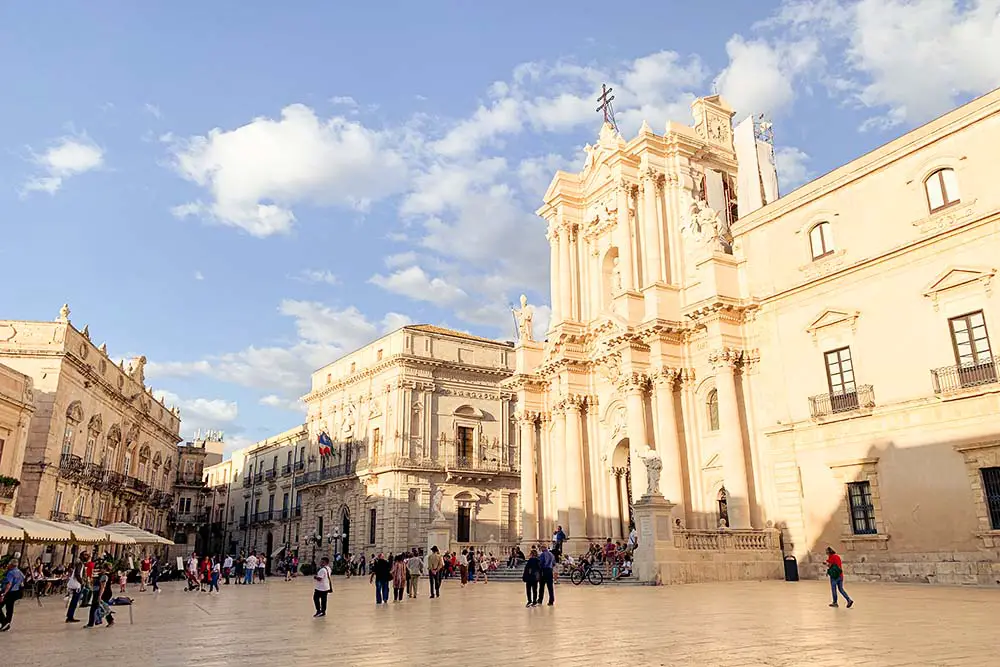
Catania main square.
What sets Catania apart? It’s not just its proximity to the looming and active Mount Etna, but also its indomitable spirit. The Catanians possess a remarkable resilience, having rebuilt their city numerous times after nature’s fury. This spirit is reflected everywhere, from the bustling markets to the spontaneous street performances.
Moreover, Catania’s cuisine is a testament to the city’s rich culture. Signature dishes like Pasta alla Norma not only satiate the taste buds but also narrate tales of its past. The confluence of sea and mountain provides a unique setting, where you can witness volcanic landscapes and sun-kissed beaches in close proximity.
While other Sicilian cities have their undeniable charm, Catania provides an unparalleled blend of nature, history, gastronomy, and spirit, making it a must-visit destination on the island.
Travel Tips and Recommendations
When journeying to Catania, it’s essential to tailor your trip according to your interests, budget, and available time. From deciding the ideal duration of stay to making the most of your finances and exploring nearby wonders, here are some pivotal guidelines to enhance your Catanian experience.
Recommended Length of Stay: How Many Days in Catania is Enough?
While you can grasp the ambiance of Catania in a day or two, truly immersing in its essence demands a little more time. A 3 to 4-day stay is optimal, allowing you to explore the main attractions, enjoy its gastronomic offerings, and even experience the nightlife. With extra days, you can delve deeper into its neighborhoods or even venture beyond the city limits.
Budgeting for Your Trip: Is Catania Sicily Expensive?
Catania, when compared to other European cities, offers a balanced mix of affordability and luxury. Accommodation and food can be found to fit all budgets. Street food like arancini or panelle can be relished for just a few euros, while upscale restaurants serve gourmet dishes at higher prices. On average, a mid-range traveler can expect to spend around €50-80 per day excluding accommodation. However, it’s always wise to check current prices and budget a little extra for unexpected expenses or splurges.
Potential Day Trips from Catania and Exploring the Val di Noto Region
The strategic location of Catania renders it a fantastic base for day trips. The Val di Noto region, a UNESCO World Heritage site, is particularly enticing. This area is renowned for its late baroque towns, built after the earthquake of 1693, with Noto being the crown jewel, exhibiting an array of spectacular architecture. Modica and Ragusa, two other significant towns, are equally captivating with their historic centers and mouth-watering chocolate traditions. Siracusa, with its ancient Greek history and the mesmerizing island of Ortigia, is another nearby gem that can be easily reached from Catania.
Conclusion
Catania, with its spirited streets, rich tapestry of history, and majestic natural wonders, offers more than just a mere glimpse into Sicily’s heart; it beckons visitors to be a part of its ongoing tale. The city’s multifaceted charm, from its historic ruins and opulent baroque architecture to its vibrant markets and culinary delights, embodies the spirit of Sicily in its purest form.
While words and pictures can paint a vivid picture, nothing compares to the real, tangible experience of wandering its alleys, tasting its authentic flavors, and immersing oneself in its bustling local life.
Every corner of Catania tells a story, waiting to be discovered, felt, and remembered. For those yearning for an authentic Sicilian experience, Catania is not just a destination, but a journey into the soul of an island steeped in history and culture.
It’s a call to every traveler’s heart to venture, explore, and, most importantly, to feel. So, pack your bags, set your sights, and let Catania enchant you, surprise you, and stay with you long after you’ve returned home.
FAQ about Visiting Catania
Is Catania Sicily worth visiting?
Absolutely! Catania is a city steeped in history, adorned with grand architecture, and surrounded by natural wonders like Mount Etna. It’s a fusion of culture, gastronomy, and vibrant street life.
What is Catania best known for?
Catania is renowned for its Baroque architecture, the bustling Catania Fish Market, the iconic dish Pasta alla Norma, and its proximity to Mount Etna, Europe’s tallest active volcano.
How many days in Catania is enough?
A three-day visit allows you to explore most of the city’s main attractions. However, spending more days will provide a richer experience, including potential day trips to nearby areas.
Is Catania nicer than Palermo?
Both cities have their unique charm. While Palermo is the larger and more historically Arabic-influenced city, Catania boasts Baroque architecture and a close connection to Mount Etna. It depends on your interests.
Is it worth staying in Catania Sicily?
Yes, staying in Catania gives you a great base to explore both the city’s attractions and nearby sights like the Val di Noto region and Isola Bella Island.
What to do in Catania in one day?
You can explore the main piazzas like Piazza del Duomo, visit historical sites like Castello Ursino, indulge in local street food, and stroll along Via dei Crociferi.
Is Catania Sicily expensive?
Catania offers a range of options for travelers on various budgets. While it’s not the cheapest city in Sicily, careful planning and budgeting can make your trip affordable.
Is Catania a walkable city?
Yes, the central parts of Catania are very walkable, with many attractions close to each other. However, for areas outside the city center or for day trips, other modes of transportation are recommended.
What is the famous street in Catania?
Via dei Crociferi is one of Catania’s most famous streets, known for its Baroque churches and historical significance.
Is Catania or Palermo better?
Neither is objectively better; both have their unique offerings. Catania is vibrant with its connection to nature, while Palermo offers a mix of cultures and a deeper historical ambiance. Choose based on your personal preferences.

